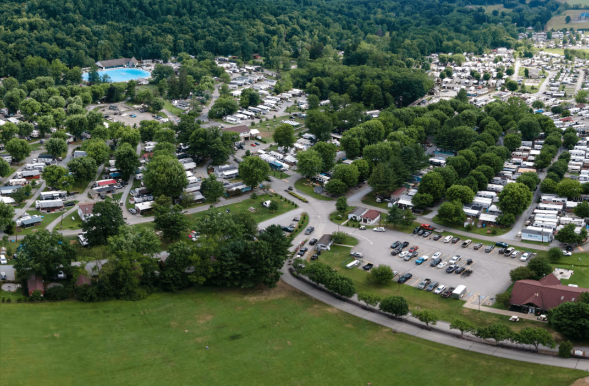
Update! The Fayette County Zoning Hearing Board has approved the conditions listed below! On August 21, the Fayette County Zoning Hearing Board approved modifications of conditions placed on the approval of a special exception requested by Diamond Properties LLC of New York for a campground on the former site of the Clifford Pritts Elementary School in Saltlick Township.
Some of the conditions include limits on the number of campsites within the campgrounds, the size and number of campfires within the site, and a requirement that no permanent structures would be created on any campsite. These changes were proposed by MWA and residents of the Indian Creek Valley who live near Mountain Pines Campground.
We’re hopeful that these new conditions will result in less environmental impact and a more peaceful atmosphere for residents of the Indian Creek Valley. Thanks to everyone who was involved!
—
The Fayette County Zoning Hearing Board will consider revisions to the Mountain Pines Campground expansion conditions on August 21st at 11:00 am in the Meeting Room of the Gallatin Building, 2 West Main Street, Uniontown, Pennsylvania. Interested persons may appear at the hearings to offer testimony.
MWA urges concerned community members who attended previous zoning hearings on this issue to attend this hearing, wear green, and provide comments on the significance of upholding the intent of the conditions to protect the public’s health, safety, and general welfare.
This comes after President Judge Steve P. Leskinen, Court of Common Pleas of Fayette County, issued an Opinion and Order on June 14, 2024, in the appeal concerning the expansion of the Mountain Pines Campground. The Opinion came almost seven months after counsel for the Fayette County Zoning Hearing Board (ZHB), Diamond Properties (owners of the campground), and Mountain Watershed provided oral argument on the three conditions appealed by the campground.
In the Judge’s Opinion, all three conditions that Diamond Properties appealed were remanded. (When a case is remanded, it is sent back to the body that made the decision – here, the ZHB – and directs them to take additional or alternative action on the decision.) From MWA’s interpretation, it appears that the judge thinks a condition limiting each of the three issues would be reasonable due to testimony offered during the hearings. However, the conditions need to be edited or reworded for them to be reasonable as they currently stand. MWA provided suggested revisions to the conditions to the ZHB after the Opinion was issued. You can review the revisions below.
MWA’s Suggested Revisions to the Conditions
Condition Limiting Size and Number of Campsites
- Original Condition: Each individual campsite shall be no larger than 50 feet by 50 feet, and the campground shall have no more than 90 campsites. No campsite shall be permitted to be constructed within the “no activity zone” as shown on the plan.
- Suggested Condition: The campground shall have no more than 90 campsites, and each campsite is limited to one structure for occupancy. No campsite shall be permitted to be constructed within the “no activity zone” as shown on the plan.
- Reasoning: The judge found that there was substantial evidence in the record to show that the size and scope of activities at the campground would have an adverse impact on the community greater than a normal campground. Additionally, the ZHB’s limit of 90 campsites appears on its face to be reasonable. The judge found that there was ambiguity surrounding the limitation on the maximum size of the campsite. Limiting the size of the campsites helps to ensure that campsites are not made so large as to support multiple park models/campers, effectively creating multiple campsites within one campsite. By limiting each campsite to one structure for occupancy, it ensures that each campsite will still only function as a single campsite and aids in the open and natural character of a campground.
Condition Limiting Size and Number of Campfires
- Original Condition: Campfires shall be no larger than 32 inches in diameter and there shall be no more than one campfire site per 10 campsites. There shall be no outside firepits permitted to be brought into the campground via patrons.
- Suggested Condition: Campfires shall be no larger than 32 inches in diameter and there shall be no more than one campfire site per 10 campsites. Smokeless firepits may be brought into the campground by patrons so long as they are less than 32 inches in diameter.
- Reasoning: The judge found that a condition that would reduce the adverse impacts of campfires to an acceptable level would be appropriate. Limiting the size and number of campfires allowed would reduce the adverse impacts of smoke, odor, and air pollution. By changing the language prohibiting outside fire pits, smokeless fire pits would now be allowed, so long as they still meet the 32-inch-diameter requirement.
Condition Prohibiting Permanent Structures
- Original Condition: There shall be no permanent structures, including but not limited to, sheds, porches, carports, awnings, or added roofs.
- Suggested Condition: There shall be no permanent structures, including but not limited to, sheds, porches, carports, awnings, or added roofs, on campers’ individual campsites.
- Reasoning: The judge found that a “condition limiting, prohibiting, or requiring the seasonal removal of structure on campsites would be reasonable to ensure that the use is consistent with a campground and not with a mobile home park or with the use of a RC as a dwelling.” The suggested condition would prohibit permanent structures from individual campsites, making the use consistent with a campground, while still allowing for accessory uses on the campground such as offices, retail stores, amusements, etc.

